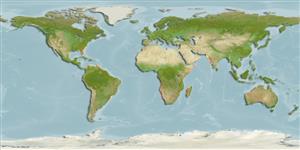Classification / Names
Common names from other countries
Main reference
Size / Weight / Age
Max length : 55.0 cm TL male/unsexed; (Ref. 3976); common length : 35.0 cm TL male/unsexed; (Ref. 3546)
Length at first maturity
Lm ?, range 25 - 27.5 cm
Environment
Marine; brackish; demersal; amphidromous (Ref. 51243); depth range ? - 120 m (Ref. 27121)
Climate / Range
Subtropical, preferred 23°C (Ref. 107945); 17°S - 11°S, 14°E - 33°E
Distribution
Southeast Atlantic: Walvis Bay, Namibia to the vicinity of East london, South Africa (Ref. 85159). Records from Guinea-Bissau as Tachysurus feliceps and from Guinea as Arius feliceps are erroneous.
Countries | FAO areas | Ecosystems | Occurrences | Introductions
Short description
Vertebrae: 51 - 52. This species is distinguished by the following characters: head longer than, or nearly as long as, broad; tooth patches are posterior to premaxillary band touch at midline; relatively long and thin maxillary barbel, extending at least to pectoral fin spine origin (longer in females); dorsal fin spine length more than 70% of its height; pectoral-fin spine at vertical extends at most to hind edge of dorsal fin base; deeply forked caudal fin with moderately slender, with pointed lobes, upper lobe longer; caudal peduncle approximately twice as long as deep; 11-14 gill-rakers on anterior face of first arch; upper two-thirds of body darkened, some lateral speckling and belly stark white; median anterior cranial fontanelle (of exposed skull) elongate and bullet-shaped; smooth and shallow median cranial depression, deepest posteriorly at frontal/supraoccipital suture. 10-12 pectoral fin rays; 51-52 (17 precaudal, 34-35 caudal) total vertebrae. Dimorphism of posterior (humeral) process of cleithrum obvious externally, in females, fan-shaped, in males triangular (Ref. 85159).
IUCN Red List Status (Ref. 115185)
Human uses
Fisheries: commercial; aquarium: public aquariums
More information
ReferencesAquacultureAquaculture profileStrainsGeneticsAllele frequenciesHeritabilityDiseasesProcessingMass conversion
Tools
Special reports
Download XML
Internet sources
Estimates of some properties based on models
Phylogenetic diversity index
PD50 = 0.5625 many relatives (e.g. carps) 0.5 - 2.0 few relatives (e.g. lungfishes)
Trophic Level
3.8 ±0.2 se; Based on diet studies.
Resilience
Medium, minimum population doubling time 1.4 - 4.4 years (Assuming tm=2-3)
Vulnerability
Moderate to high vulnerability (52 of 100)
Price category
